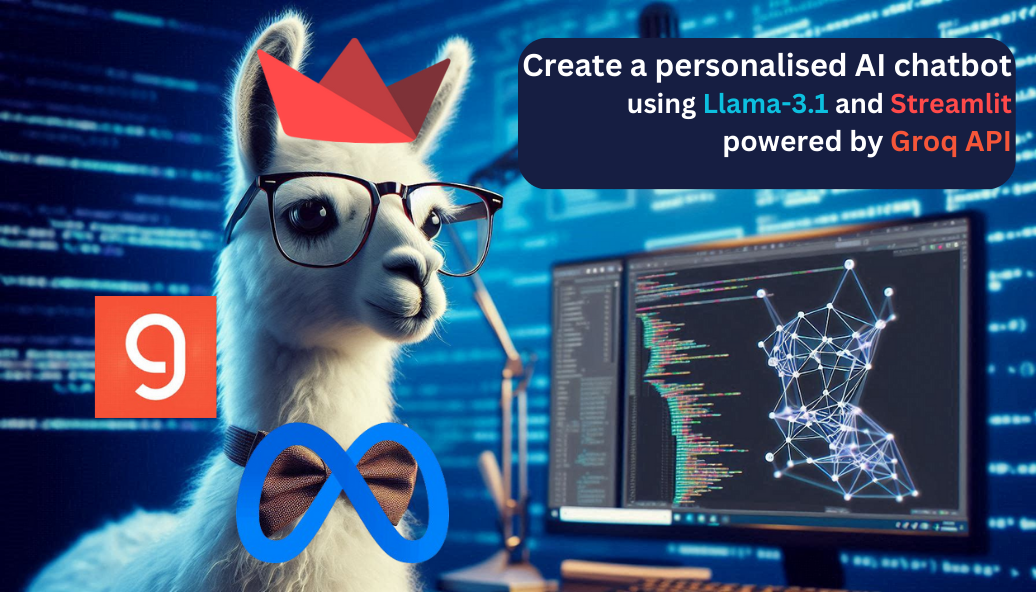Create an end-to-end personalised AI chatbot🤖 using Llama-3.1🦙 and Streamlit powered by Groq API
 Debapriya Das
Debapriya Das
In this tutorial, we'll build and deploy a personalised AI-powered chat application using Streamlit and the latest AI model llama-3.1-8b-instant. We'll use Groq for faster inference. Also we are going to deploy it for free! We'll take you through the code, explaining each section and providing useful tips for customization.
Getting Started
First sign in to https://groq.com/ and click start building

Click on Create API key then create a new key, copy it and keep it somewhere safe.

Now install the necessary libraries: Create the requirements.txt file and paste this
groq==0.9.0
streamlit==1.37.0
python-dotenv
Install these using
pip install -r requirements.txt
Let's create our main.py file and import the required libraries:
import os
from dotenv import dotenv_values
import streamlit as st
from groq import Groq
We'll use streamlit for building the chat interface, dotenv for handling environment variables, and groq for fast inference from the AI model.
Configuring the Page
Let's set up the page configuration using Streamlit:
st.set_page_config(
page_title="The Tech Buddy ",
page_icon="",
layout="centered",
)
This will give our chat application a professional look and feel.
Handling Environment Variables
We'll use environment variables to store sensitive information like API keys and and the application specific prompts. In your root folder create a .env file like this:
GROQ_API_KEY='YOUR_GROQ_API_KEY'
INITIAL_RESPONSE="Enter what you want to show as the first response of your bot, example: Hello! my friend I am a painter from 70's. Whatsup?"
CHAT_CONTEXT="Enter how do you want to personalize your chatbot, example: You are a painter from the 70's and you are respond sentences with painting references.(This is for the system)"
INITIAL_MSG="Enter the first message from the assistant to initiate the chat history, example: Hey there! I know everything about painting, ask me anything.(This is for the assistant)"
This part is crucial to personalize your application as per your need. So play with it and explore.
Now configure this environment variables in our python file:
try:
secrets = dotenv_values(".env") # for dev env
GROQ_API_KEY = secrets["GROQ_API_KEY"]
except:
secrets = st.secrets # for streamlit deployment
GROQ_API_KEY = secrets["GROQ_API_KEY"]
# Save the API key to environment variable
os.environ["GROQ_API_KEY"] = GROQ_API_KEY
INITIAL_RESPONSE = secrets["INITIAL_RESPONSE"]
INITIAL_MSG = secrets["INITIAL_MSG"]
CHAT_CONTEXT = secrets["CHAT_CONTEXT"]
In the try block we are getting the environment variables from the .env file to run it and test it locally. But when we'll deploy it using streamlit we will not get any access of the .env file. So that time we will store our secrets using streamlit and to access those secrets we will use st.secretes that returns a python dict, same like dotenv_values(".env"). So after deployment the except block gets executed.
Initializing the Chat Application
Let's set up the chat history and initialize the AI model:
- Copy your favourite AI-model's
Model IDfrom https://console.groq.com/docs/models:

I used llama-3.1-8b-instant for my project.
- Initialize your model:
# Initialize the chat history if present as Streamlit session
if "chat_history" not in st.session_state:
st.session_state.chat_history = [
{"role": "assistant",
"content": INITIAL_RESPONSE
},
]
client = Groq()
We'll store the chat history in the st.session_state object, which allows us to persist data across session refreshes.
Displaying the Chat Application
Let's create the chat interface using Streamlit:
# Page title
st.title("Hey Buddy!")
st.caption("Let's go back in time...")
# Display chat history
for message in st.session_state.chat_history:
with st.chat_message("role", avatar=''):
st.markdown(message["content"])
We'll use the st.chat_message function to display each message in the chat history.
User Input Field
Let's create a text input field for the user to enter their question:
user_prompt = st.chat_input("Let's chat!")
When the user submits their prompt, we'll append it to the chat history and generate a response from the AI model.
Generating a Response from the AI Model
Let's create a response from the AI model using the Groq library:
def parse_groq_stream(stream):
for chunk in stream:
if chunk.choices:
if chunk.choices[0].delta.content is not None:
yield chunk.choices[0].delta.content
if user_prompt:
with st.chat_message("user", avatar=""):
st.markdown(user_prompt)
st.session_state.chat_history.append(
{"role": "user", "content": user_prompt})
messages = [
{"role": "system", "content": CHAT_CONTEXT
},
{"role": "assistant", "content": INITIAL_MSG},
*st.session_state.chat_history
]
stream = client.chat.completions.create(
model="llama-3.1-8b-instant",
messages=messages,
stream=True # for streaming the message
)
response = st.write_stream(parse_groq_stream(stream))
st.session_state.chat_history.append(
{"role": "assistant", "content": response})
We'll use the client.chat.completions.create() method to generate a steam and then parse it to a actual response from the AI model, and then append it to the chat history.
Run it locally
Congratulations! You've built a personalised AI-powered chat application using Streamlit, Groq, and a llama-3.1-8b-instant model.
Here is the whole main.py file:
import os
from dotenv import dotenv_values
import streamlit as st
from groq import Groq
def parse_groq_stream(stream):
for chunk in stream:
if chunk.choices:
if chunk.choices[0].delta.content is not None:
yield chunk.choices[0].delta.content
# streamlit page configuration
st.set_page_config(
page_title="The 70's Painter",
page_icon="🎨",
layout="centered",
)
try:
secrets = dotenv_values(".env") # for dev env
GROQ_API_KEY = secrets["GROQ_API_KEY"]
except:
secrets = st.secrets # for streamlit deployment
GROQ_API_KEY = secrets["GROQ_API_KEY"]
# save the api_key to environment variable
os.environ["GROQ_API_KEY"] = GROQ_API_KEY
INITIAL_RESPONSE = secrets["INITIAL_RESPONSE"]
INITIAL_MSG = secrets["INITIAL_MSG"]
CHAT_CONTEXT = secrets["CHAT_CONTEXT"]
client = Groq()
# initialize the chat history if present as streamlit session
if "chat_history" not in st.session_state:
# print("message not in chat session")
st.session_state.chat_history = [
{"role": "assistant",
"content": INITIAL_RESPONSE
},
]
# page title
st.title("Hey Buddy!")
st.caption("Let's go back in time...")
# the messages in chat_history will be stored as {"role":"user/assistant", "content":"msg}
# display chat history
for message in st.session_state.chat_history:
# print("message in chat session")
with st.chat_message("role", avatar='🤖'):
st.markdown(message["content"])
# user input field
user_prompt = st.chat_input("Ask me")
if user_prompt:
# st.chat_message("user").markdown
with st.chat_message("user", avatar="🗨️"):
st.markdown(user_prompt)
st.session_state.chat_history.append(
{"role": "user", "content": user_prompt})
# get a response from the LLM
messages = [
{"role": "system", "content": CHAT_CONTEXT
},
{"role": "assistant", "content": INITIAL_MSG},
*st.session_state.chat_history
]
# Display assistant response in chat message container
with st.chat_message("assistant", avatar='🤖'):
stream = client.chat.completions.create(
model="llama-3.1-8b-instant",
messages=messages,
stream=True # for streaming the message
)
response = st.write_stream(parse_groq_stream(stream))
st.session_state.chat_history.append(
{"role": "assistant", "content": response})
To run it locally enter the following command in your terminal:
streamlit run main.py
Deployment
We are now all set to deploy our app. First upload the codebase in a GitHub repository. Then click here to sign in to your streamlit account and go to My Apps section:
Click on
Create appat the upper right corner.Click on first option:
Locate your github repository:
Locate the your
main.pyfile:Create a custom url for your deployed app(optional):
Click on
additional settingsand paste everything from your.envfile (this is thest.secrets):Click on deploy:
Congrats! you have successfully deployed your own personalised AI app for free.
Conclusion
This tutorial should give you a solid foundation for creating engaging chat interfaces in your future projects.
Additional Tips
Make sure to handle errors and exceptions properly to provide a smooth user experience.
Customize the chat interface to fit your application's theme and design.
Experiment with different AI models and fine-tune the chat application to improve its accuracy and performance.
I hope this tutorial has been helpful! If you have any questions or need further clarification on any section, feel free to ask in the comments below.
Recourses
Click here to checkout my implementation of a personalized DSA instructor app https://the-tech-buddy.streamlit.app/ Source code: https://github.com/Debapriya-source/llama-3.1-chatbot
Subscribe to my newsletter
Read articles from Debapriya Das directly inside your inbox. Subscribe to the newsletter, and don't miss out.
Written by

Debapriya Das
Debapriya Das
About Passionate about driving innovation through technology, I am transitioning into the world of DevOps with a solid foundation in Generative AI, Machine Learning, and Backend Development. My experience spans developing advanced algorithms, designing scalable backend systems, and fostering data-driven decision-making. I am eager to leverage my technical expertise to streamline operations, enhance automation, and implement continuous integration and deployment practices. Committed to fostering a culture of collaboration and efficiency, I aim to contribute to the seamless delivery of high-quality software solutions. Let's connect and explore how we can drive technological excellence together.